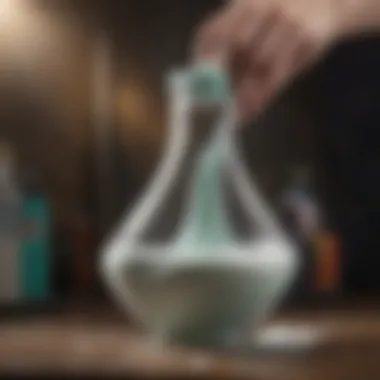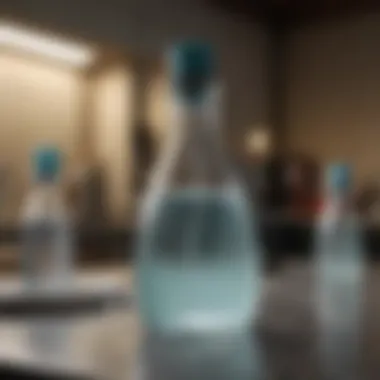How to Make Elephant Toothpaste at Home: A Fun Guide


Intro
Creating elephant toothpaste at home not only serves as an exciting science demonstration but also offers a fascinating glimpse into the underlying chemistry. This activity captivates audiences due to its dramatic visual impact and the educational value it provides. While it is often associated with science fairs and classrooms, the experiment can be conducted in a domestic setting with proper preparation and understanding.
The typical components of this experiment include hydrogen peroxide, dish soap, yeast, and warm water. These ingredients combine to produce a foamy eruption that resembles toothpaste suitable for a giant. Furthermore, engaging in this experiment can lead to discussions about exothermic reactions, catalysis, and the decomposition of hydrogen peroxide.
This article will guide you through the necessary preparations required for making elephant toothpaste safely and effectively. It aims to serve both educational purposes and to fuel the curiosity of individuals interested in chemistry.
Research Overview
Summary of Key Findings
The core aspect of the elephant toothpaste reaction comprises the breakdown of hydrogen peroxide. When combined with the yeast, a catalyst, this reaction releases oxygen gas rapidly. This swift release creates bubbles in the soapy solution, resulting in a voluminous and colorful outcome. It is essential to understand the role of each ingredient in this process.
- Hydrogen Peroxide: The primary reactant that breaks down under the influence of the catalyst.
- Yeast: Contains enzymes that speed up the breakdown of hydrogen peroxide.
- Dish Soap: Traps the released oxygen to form bubbles, resulting in foam.
- Warm Water: Activates the yeast, making the reaction more vigorous.
Significance of Research
Understanding this reaction is vital in multiple fields, from education to practical applications in industries like cosmetics and food processing. The principles at play enhance knowledge of chemical reactions, particularly exothermic reactions, where heat is released, making it an excellent tool for educators and students alike.
Moreover, the colorful display resulting from various additives, such as food coloring, can be used to demonstrate principles in visual learning. Capturing the imagination of students helps foster a deeper appreciation for chemistry.
"The elephant toothpaste experiment serves not only as a visual spectacle but as a practical demonstration of scientific principles in action."
Methodology
Research Design
This article's design revolves around combining practical experimentation with theoretical knowledge. The focus is on the educational aspects of the elephant toothpaste experiment while ensuring it's accessible for at-home execution.
Data Collection Methods
- Observational notes during the reaction to detail the speed and characteristics of the foam produced.
- Reviewing existing literature on chemical reactions and previous studies about similar experiments. Relevant sources such as Britannica and Wikipedia provide ample foundational information.
Prelude to Elephant Toothpaste
Elephant toothpaste is an engaging and visually impressive science demonstration that has garnered interest among students, educators, and science enthusiasts. This activity not only serves as an entertaining experiment but also provides insight into chemical reactions, making it a valuable educational tool. Understanding how elephant toothpaste is made involves exploring the necessary materials, safety precautions, and the scientific principles that underlie the reaction. This article aims to dissect these elements, enriching readers' knowledge while inspiring them to experiment in their own homes.
What is Elephant Toothpaste?
Elephant toothpaste refers to a popular chemistry experiment that produces a rapid foam eruption, resembling a giant stream of toothpaste that could theoretically fill the mouth of an elephant. The reaction occurs when hydrogen peroxide decomposes, usually in the presence of a catalyst, leading to the release of oxygen gas. This gas gets trapped in the soap, creating a large volume of foam that spills over the container.
Typically, the demonstration uses common household items, making it an accessible experiment for many. The result is not only visually fascinating but also a tangible application of basic chemistry principles in action. It's important to note that the scale of the reaction can be adjusted based on the amounts of ingredients used, allowing for varying degrees of excitement.
Origins of the Experiment
The elephant toothpaste experiment has become a staple in educational science demonstrations, but its origins can be traced back to the study of catalytic reactions. The experiment gained significant popularity in the early 2000s, particularly among science teachers looking for engaging ways to illustrate chemical concepts in classrooms. Its roots lie deeply in principles of oxidation, with the initial formulation attributed to research in chemistry pertaining to the catalysis of hydrogen peroxide.
Today, variations of the experiment utilize different catalysts, showcasing how minor changes in chemical processes can lead to significant differences in outcomes. Schools and science fairs often adopt this demonstration to spark curiosity in young minds, emphasizing the intersection of chemistry and creativity. Educators recognize its potential to captivate students' attention while fostering a deeper understanding of scientific principles.
Scientific Principles Behind the Reaction
Understanding the scientific principles that underlie the elephant toothpaste experiment is crucial for both educational and practical purposes. The reaction demonstrates important concepts in chemistry while engaging participants in a hands-on learning experience. By grasping the scientific principles, individuals can appreciate the phenomenon of chemical reactions on a deeper level, making the process more than just a visual spectacle.
Chemical Reaction Overview
At the core of the elephant toothpaste experiment is a rapid decomposition reaction. This reaction primarily involves hydrogen peroxide, a common household chemical. When hydrogen peroxide breaks down, it separates into water and oxygen gas. This process can be represented by the following equation:
[ 2 H_2O_2 \rightarrow 2 H_2O + O_2 \uparrow ]
The release of oxygen creates a large volume of foam, giving the appearance of "toothpaste". The substance that forms the base of the foam is actually soap, which helps trap the oxygen gas as bubbles. The visual effects, which are often enhanced by the addition of food coloring, make this reaction fascinating to observe.


Role of Catalysts
In this experiment, catalysts play a vital role in accelerating the decomposition of hydrogen peroxide. Yeast and potassium iodide are the most commonly used catalysts. Catalysts lower the activation energy required for the reaction to occur. As a result, they facilitate the process, allowing the reaction to happen much faster than it would without a catalyst.
When yeast is used, enzymes within the yeast cells accelerate the breakdown of hydrogen peroxide. Potassium iodide, on the other hand, provides iodide ions which speed up the release of oxygen gas. This is crucial, as the rapid release of oxygen contributes significantly to the impressive foam creation. Without these catalysts, the reaction would take much longer to achieve the same visual effect.
Indicators of Reaction Rate
Several factors can indicate how quickly the reaction is occurring. One clear indicator is the volume of foam produced. A swift and abundant production of foam usually indicates a high reaction rate. Additionally, you may observe how quickly the foam overflows from the container used, which showcases the effectiveness of the reaction.
Moreover, measuring the temperature of the mixture before and after the reaction provides insight. Exothermic reactions, which release heat, can help further understand the dynamics of the chemical processes involved. Lastly, the clarity and size of the bubbles can also serve as visual indicators. Larger bubbles typically indicate a faster production of oxygen gas, enhancing the overall reaction speed.
"Understanding the scientific principles in experiments like elephant toothpaste not only fosters curiosity but also enhances critical thinking skills among students and educators alike."
Materials Required
The section on materials required is pivotal in the discussion of elephant toothpaste. It lays the groundwork for the entire experiment, ensuring that participants have the proper components to create this visually striking reaction. Using the right materials not only affects the quality and safety of the experiment but also influences the overall outcome, making it a critical focus for this guide.
Essential Ingredients
Hydrogen Peroxide
Hydrogen peroxide is central to the elephant toothpaste reaction. It acts as the primary oxidizer, breaking down into water and oxygen upon decomposition. This process creates the frothy eruption that characterizes elephant toothpaste. Typically, a concentration of 6% or 3% hydrogen peroxide is used in home experiments, while higher concentrations yield more vigorous results. However, higher concentrations can also be more dangerous, requiring careful handling. Therefore, 3% hydrogen peroxide is often recommended for safety.
Dish Soap
Dish soap plays a crucial role in this experiment, as it helps to trap the oxygen released from the decomposition of hydrogen peroxide. The soap forms bubbles, which contributes to the foamy appearance of the reaction. Additionally, dish soap is generally safe and easily accessible. Its function in emulsifying the mixture makes it a popular choice in the recipe. If using a dish soap with additional components, ensure that they do not inhibit the reaction.
Yeast or Potassium Iodide
Yeast is a living organism that acts as a catalyst in the reaction. When mixed with warm water, the yeast becomes activated, producing enzymes that effectively speed up the breakdown of hydrogen peroxide. Potassium iodide is another effective catalyst that can be used. Both options are beneficial due to their efficiency in facilitating the reaction, enhancing the visual impact of the resulting foam. Yeast is a more common household item, while potassium iodide may need to be procured from a science supply store.
Warm Water
Warm water is often used to activate the yeast in the reaction. The heat can speed up the process of activation, making the reaction more robust and quicker. While warm water itself does not contribute to the chemical reaction directly, its role in ensuring the yeast operates efficiently is essential. Always take care to not use boiling water, as this could kill the yeast, rendering it ineffective for the experiment.
Food Coloring
Food coloring is not necessary for the basic reaction, but it adds visual appeal, making the experiment more engaging. By incorporating food coloring into the mixture, participants can create vivid displays of foamy toothpaste in various colors. This aspect also allows for personalization and creativity in the experiment, which can enhance the educational experience. Ensure to use gel or liquid coloring that is compatible with the other components.
Equipment and Tools
Empty Plastic Bottle
An empty plastic bottle serves as the reaction vessel. This choice of container is beneficial because it withstands the pressure generated by the gas release during the reaction. Additionally, the bottle's shape allows for easy visualization of the foam as it erupts. It is essential to select a bottle that is durable enough to handle a vigorous reaction but also safe to dispose of after use.
Measuring Cups and Spoons
Accurate measurement of the ingredients is crucial in this experiment. Measuring cups and spoons ensure that the ratios of hydrogen peroxide, soap, and other components are correct, which directly affects the outcome of the reaction. They also promote a better understanding of the chemistry involved, as precise amounts yield specific results. These tools are commonplace in most kitchens, making them accessible for a wide range of participants.
Mixing Container
Before adding the ingredients to the plastic bottle, a separate mixing container is necessary to incorporate the components efficiently. A mixing container helps to combine the ingredients smoothly, ensuring that the reaction occurs evenly. Using a container that is easy to clean will simplify the cleanup process afterward. Select a container that can handle liquids without leaking.
Spoon or Stirring Rod
A spoon or stirring rod is required to mix the ingredients in the mixing container thoroughly. This simple tool assists in achieving a consistent mixture, which is essential for an effective reaction. The choice between a spoon and a rod may depend on personal preference, but both will adequately serve the purpose. Ensure that whatever tool is used is durable and can withstand some degree of pressure from stirring.
Safety Goggles and Gloves
Safety goggles and gloves are non-negotiable for this experiment. Safety goggles protect the eyes from any potential splashes or debris, whereas gloves afford protection for the hands when handling chemicals. Keeping safety as a priority is essential, as even common household items can cause irritation or allergies. Both items are readily available and important for a safe learning experience.
Safety Precautions


Safety precautions are critical when conducting the elephant toothpaste experiment. The reaction involved can generate a significant volume of foam that may overflow if not managed properly. Additionally, the chemicals used, particularly hydrogen peroxide, can pose risks if mishandled. Therefore, understanding and implementing safety measures ensures the experiment is conducted responsibly, minimizing hazards while maximizing educational value.
Proper Protective Gear
Using the appropriate protective gear is essential for safeguarding individuals involved in the experiment. Recommended attire includes:
- Safety goggles: These should be worn to protect eyes from splashes or spills, particularly from hydrogen peroxide which can cause irritation.
- Gloves: Disposable gloves not only keep your skin safe from chemical contact but also help maintain hygiene when handling any materials.
- Lab coat or apron: This provides an additional layer of protection for your clothing and skin. It is advisable to use materials that are resistant to chemical spills.
By wearing these items, participants can engage in the experiment with reduced risk, allowing for a more enjoyable experience.
Handling Chemicals Safely
When working with chemicals in any reaction, cautious handling is imperative. Here are some key practices to consider:
- Always read the labels and instructions on chemical containers before use. Familiarize yourself with any potential hazards or reactivity issues.
- Use plastic containers to measure and mix materials. Avoid using metal containers, especially for hydrogen peroxide, as it may react negatively.
- Measure ingredients carefully and avoid adding more than the recommended quantities. This experiment involves a rapid reaction, and excess material can lead to unexpected outcomes.
- Keep flammable materials away from the experiment area and ensure proper ventilation. That minimizes risks associated with the release of potentially harmful fumes.
By adhering to these practices, individuals can ensure a safer experiment, reducing the likelihood of accidents and promoting a focus on the educational aspects of the demonstration.
Cleanup Procedures
After completing the experiment, thorough cleanup is crucial to maintain a safe environment. Follow these steps for effective cleanup:
- Allow any remaining foam to subside before attempting to clean up. The foam can cause slippery surfaces; thus, exercise caution.
- Dispose of used materials properly, following local regulations on hazardous waste. Never pour chemicals down the drain without confirming it is safe to do so.
- Clean any spills immediately, using warm water and soap. This will help neutralize any chemicals that may have come into contact with the surfaces.
- Wash hands thoroughly after removing gloves and handling materials, regardless if gloves were worn.
Implementing these cleanup procedures not only keeps the workspace safe but also instills good laboratory practices in participants.
Step-by-Step Instructions
The section on step-by-step instructions serves as a crucial guide for readers who want to recreate the elephant toothpaste experiment safely and effectively. By breaking down the process into clearly defined stages, readers can follow along without confusion. Well-structured instructions not only enhance the safety of the experiment but also facilitate understanding of the underlying chemistry. This systematic approach is essential for both novices and experienced individuals looking to achieve reproducible results.
Preparing the Mixture
Preparing the mixture is the first stage of creating elephant toothpaste. This step is critical as it involves combining various ingredients that will trigger the chemical reaction. To begin, gather all necessary materials. This includes hydrogen peroxide, dish soap, yeast or potassium iodide, warm water, and food coloring. The food coloring adds visual appeal but does not influence the chemical process.
In a mixing container, combine the hydrogen peroxide and a few drops of dish soap. Stir gently to ensure everything is well blended. It is important to handle hydrogen peroxide with care, as it can be corrosive in higher concentrations. If you are using yeast, activate it by dissolving it in warm water for about 30 minutes. This step is crucial as it allows the yeast to serve effectively as a catalyst during the reaction.
Conducting the Experiment
Once your mixture is prepared, it is time to conduct the experiment. Pour the activated yeast solution into the container holding the hydrogen peroxide and dish soap mixture. This is where the excitement begins. The reaction will produce oxygen gas rapidly, creating a foamy eruption.
It’s wise to conduct this step outside or over a large tray to avoid mess. Ensure you have your safety goggles and gloves on during the process. At this stage, you can also add food coloring to enhance the visuals of the reaction. The color will swirl through the foam, creating a striking effect that impresses onlookers.
Observing the Reaction
Observing the reaction provides valuable insights into the chemical process occurring. As the yeast acts as a catalyst, it breaks down the hydrogen peroxide into water and oxygen gas. This reaction produces an enormous volume of foam, resembling toothpaste on a large scale.
Take notes during this stage, as understanding the timeline of the reaction can be an educational tool. You may watch as the foam rises rapidly and overflows, while analyzing how different factors, such as the concentration of hydrogen peroxide or the amount of yeast, impact the reaction rate.
"The most enlightening moments of this experiment derive from careful observation and analytical thinking."
Understanding Variations
Scaling the Experiment
Scaling the experiment involves adjusting the quantities of the ingredients while maintaining the same ratios. This can help in observing how larger or smaller proportions affect the reaction. For instance, if one were to double the amount of hydrogen peroxide and yeast, the resultant foam could potentially overflow more vigorously. Scientists often scale experiments when conducting research or demonstrations to evaluate the consistency of results across different settings.
When scaling, consider the following elements:
- Container Size: A larger container can manage increased foam and avoid spills.
- Ingredient Ratios: Maintaining the correct ratios is crucial for a successful reaction.
- Observation: A larger scale may present the opportunity to explore how changes affect foam height and duration.
Using Different Catalysts


The choice of catalyst significantly influences the speed and intensity of the reaction. Yeast and potassium iodide are common catalysts used in the elephant toothpaste experiment. Each catalyst initiates the breakdown of hydrogen peroxide at different rates. By experimenting with various catalysts, you can observe varying degrees of foam production.
Some catalysts to consider include:
- Yeast: A biological catalyst allowing for a gradual reaction.
- Potassium Iodide: A chemical catalyst for an enhanced and quicker reaction.
- Baking Soda: While not traditional, it can yield interesting foam effects in specific trials.
Exploration of different catalysts can provide insights into the principles of catalysis and reaction dynamics, making the process educational and enlightening.
Altering Visual Effects
Visual effects are another area where variations can take place. By incorporating food coloring or using different mixtures, the aesthetic appeal of the elephant toothpaste can be improved, creating colorful demonstrations. This is particularly useful for classroom environments engaging students in science.
Some ways to alter the visual effects include:
- Using Different Colors: Instead of a single color, using multiple hues can create a more striking visual.
- Layering: Introducing colors at different layers or in specific sequences can produce diverse results.
- Varying Additives: Some may choose to add glitter or other safe materials to enhance texture and appearance.
Experimenting with visual effects not only makes the demonstration more captivating but also encourages creativity in scientific exploration.
By understanding these variations, enthusiasts can cultivate a deeper appreciation for the complexities involved in chemical reactions. Using various scaling techniques, catalysts, and visual enhancements opens up a broader horizon for experimentation, making this activity both educational and entertaining.
Applications and Educational Insights
The applications and educational insights of creating elephant toothpaste at home extend beyond just the visual flair of the reaction itself. This experiment serves as a potential touchpoint for cross-disciplinary learning. It encapsulates principles of chemistry, biology, and even physics, making it a versatile subject in both classroom settings and informal learning environments.
Engaging in this activity cultivates curiosity among students of all ages. It promotes hands-on learning experiences where theoretical knowledge meets real-world applications. Understanding the chemical reactions can lead to deeper discussions about catalysts, reaction rates, and safety protocols. As students see the experiment unfold, their engagement deepens, spurring further inquiry into science.
Demonstrations in Education
In a classroom setting, elephant toothpaste provides an exciting opportunity for demonstrations. Teachers can use this experiment to showcase the real-time effects of chemical reactions. The mixing of common household ingredients to create a visually stimulating product captures attention. From middle school science fairs to university-level laboratory courses, this demonstration scales well with age and understanding.
The simplicity of the experiment allows educators to easily prepare and perform it with limited resources. Key points to consider during such demonstrations include:
- Safety Training: Prior preparation on safety measures enhances the educational experience. Students must understand why protective gear is necessary.
- Interactive Participation: Involving students in the process heightens their interest. For instance, allowing them to measure ingredients fosters a sense of ownership in their learning.
- Question and Answer Sessions: Following the demonstration, engaging students in discussions about what they observed can reinforce learning outcomes. This approach brings potential misconceptions to light and reaffirms concepts in chemistry.
Exploring Chemical Reactions
Elephant toothpaste serves as an effective gateway for exploring chemical reactions in detail. The experiment provides a tangible example of exothermic reactions and the role of catalysts. In this case, yeast or potassium iodide serves as the catalyst, averting the complexity often found in more advanced discussions.
Students can analyze and hypothesize why certain ingredients create explosive foam while others do not. This inquiry-based exploration helps nurture critical thinking skills.
Key areas of exploration include:
- Understanding Reactants: Investigation of how hydrogen peroxide decomposes in yeast or potassium iodide gives insight into the principles of oxidation-reduction reactions.
- Impact of Variables: Discussing how variations in temperature or concentration affect reaction outcomes can spark a more nuanced understanding of chemistry.
- Visualizing Science: The dramatic outcome of the experiment allows students to see science in action. It reinforces theoretical knowledge through practical experience, which can be more effective than passive learning alone.
In addition to fostering a deeper understanding of chemistry, the experiment encourages students to discuss the implications of chemical reactions in real life. This can lead to conversations about environmental science, safety in chemical handling, and the importance of scientific experimentation in society.
End
Summation of Key Points
To summarize the key points:
- Concept and Components: Elephant toothpaste is produced using hydrogen peroxide, yeast or potassium iodide, dish soap, and warm water. Each ingredient plays a crucial role in generating the frothy eruption characteristic of this experiment.
- Safety Precautions: Ensuring safety during the experiment is paramount. Wearing protective gear, such as gloves and goggles, minimizes risks when handling chemicals.
- Scientific Principles: The reaction is a demonstration of exothermic processes and the catalysts that speed them up. Understanding these principles enhances the learning experience.
- Educational Value: This activity can be beneficial in educational settings, proving effective in engaging students with hands-on experience while explaining scientific concepts.
Encouragement to Experiment
Experimentation is a vital component of learning. Trying out the elephant toothpaste project at home provides practical understanding that cannot be obtained from textbooks alone.
- Feel free to modify variables, like changing the concentration of hydrogen peroxide or introducing different catalysts, to observe varying outcomes.
- Documenting results assists in grasping the experiment's nuances and fosters analytical thinking skills.
- Sharing findings with peers or educators can lead to discussions that deepen understanding and promote collaborative learning.
In essence, do not hesitate to take on this project. The act of doing reinforces learning in ways that theoretical approaches often cannot.
Citations and Further Reading
For those interested in exploring more about the fascinating world of chemical reactions and safe experiments at home, several sources are invaluable:
- Wikipedia offers a broad overview of chemical reactions, providing a general context that can enhance understanding of the elephant toothpaste experiment. A good starting point is the Chemical Reaction page.
- Britannica provides detailed articles on related topics defining specific terms and scientific concepts. Their resources often include in-depth analyses that can help contextualize the experiment.
- Reddit has numerous community discussions about science experiments. These forums can offer practical tips and anecdotal experiences from individuals who have tried making elephant toothpaste themselves.
- Facebook groups dedicated to science experiments can be a great place to connect with others interested in similar activities. These platforms allow for sharing insights and discussing techniques to enhance the elephant toothpaste experience.
Incorporating citations from reputable sources not only validates the content but also contributes to a culture of informed experimentation. Readers should take advantage of these references to broaden their horizons and deepen their knowledge base.



